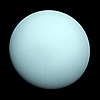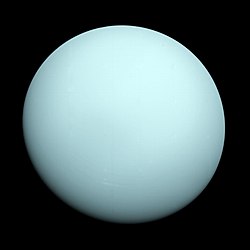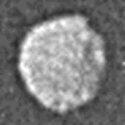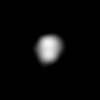Uranus naturliga satelliter
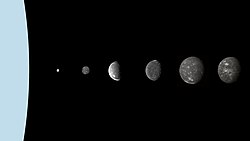
Uranus har 28 bekräftade månar,[1] varav de fem största är Miranda, Ariel, Umbriel, Titania och Oberon. Månarna har fått sina namn efter rollfigurer i William Shakespeares och Alexander Popes verk.[2]
Översikt
I tabellen nedan på denna sida finns Uranus månar sorterande efter stigande medelavstånd till Uranus. För en alfabetisk översikt över månarna, se Kategori:Uranus månar.
Upptäckt
William Herschel fann de två tidigast kända månarna 13 mars 1787, nämligen Oberon och Titania. År 1851 kunde William Lassell lägga till Ariel och Umbriel till listan och 1948 upptäckte Gerard Kuiper månen Miranda.
Rymdsonden Voyager 2 flög förbi Uranus och dess månar i januari 1986 och vid denna resa upptäckte man ytterligare tio månar. Senare upptäcktes en elfte måne, Perdita (då känd som S/1986 U 10) genom att undersöka Voyagerbilderna igen.
Sedan Voyager har man från observatorier på jorden funnit ytterligare 12 månar.[3][4][5]
Namngivning
År 1852 lade William Herschels son John Herschel fram ett förslag om att uppkalla månarna efter verk av William Shakespeare och Alexander Pope, och bröt därmed med tidigare tradition att välja namn ur den grekiska mytologin. Denna idé används fortfarande och alla månar har fått namn efter detta.[3][5]
Vissa småplaneter har samma namn som några av Uranus månar: 171 Ophelia, 218 Bianca, 593 Titania, 666 Desdemona, 763 Cupido och 2758 Cordelia.[6]
Tabell över Uranus kända månar
| Färgförklaring | ||||
|---|---|---|---|---|
| Inre månar | Stora månar | Ogrupperade prograda irreguljära månar | Ogrupperade retrograda irreguljära månar | Caliban gruppen |
| Nummer | Namn[1] | Bild | Omloppsbanans halva storaxel (km)[1] | Diameter (km)[1] | Omloppstid (dagar)[1] | Inklination (°)[1] | Upptäcktsår[4] | |
|---|---|---|---|---|---|---|---|---|
| 1 | Uranus VI | Cordelia | 49 800 | 40 | 0,335 | 0,085 | 1986 | |
| 2 | Uranus VII | Ophelia | 53 800 | 42 | 0,376 | 0,104 | 1986 | |
| 3 | Uranus VIII | Bianca | 59 200 | 51 | 0,435 | 0,193 | 1986 | |
| 4 | Uranus IX | Cressida | 61 800 | 80 | 0,464 | 0,006 | 1986 | |
| 5 | Uranus X | Desdemona | 62 700 | 64 | 0,474 | 0,113 | 1986 | |
| 6 | Uranus XI | Juliet | 64 400 | 93 | 0,493 | 0,065 | 1986 | |
| 7 | Uranus XII | Portia | 66100 | 135 | 0,513 | 0,059 | 1986 | |
| 8 | Uranus XIII | Rosalind | 69 900 | 72 | 0,558 | 0,279 | 1986 | |
| 9 | Uranus XXVII | Cupid | 74 392 | 10 | 0,613 | 0,099 | 2003 | |
| 10 | Uranus XIV | Belinda |  | 75 300 | 80 | 0,624 | 0,031 | 1986 |
| 11 | Uranus XXV | Perdita | 76 417 | 20 | 0,638 | 0,470 | 1986 | |
| 12 | Uranus XV | Puck |  | 86 000 | 162 | 0,762 | 0,319 | 1985 |
| 13 | Uranus XXVI | Mab | 97 736 | 10 | 0,923 | 0,134 | 2003 | |
| 14 | Uranus V | Miranda |  | 129 900 | 471 | 1,41 | 4,338 | 1948 |
| 15 | Uranus I | Ariel |  | 190 900 | 1 158 | 2,52 | 0,041 | 1851 |
| 16 | Uranus II | Umbriel |  | 266 000 | 1 169 | 4,14 | 0,128 | 1851 |
| 17 | Uranus III | Titania | 436 300 | 1 578 | 8,71 | 0,079 | 1787 | |
| 18 | Uranus IV | Oberon |  | 583 500 | 1 522 | 13,46 | 0,068 | 1787 |
| 19 | Uranus XXII | Francisco | 4 276 000 | 22 | 266,6 | 145,2 | 2001 | |
| 20 | Uranus XVI | Caliban | 7 231 000 | 72 | 579,7 | 140,9 | 1997 | |
| 21 | S/2023 U 1 | 7 999 500 | 8 | 679,4 | 141,9 | 2023 | ||
| 22 | Uranus XX | Stephano | 8 004 000 | 32 | 677,4 | 144,1 | 1999 | |
| 23 | Uranus XXI | Trinculo | 8 504 000 | 18 | 759,0 | 167,1 | 2001 | |
| 24 | Uranus XVII | Sycorax | 12 179 000 | 150 | 1 288,3 | 159,4 | 1997 | |
| 25 | Uranus XXIII | Margaret | 14 345 000 | 20 | 1 694,8 | 56,6 | 2003 | |
| 26 | Uranus XVIII | Prospero | 16 256 000 | 50 | 1 977,3 | 152,0 | 1999 | |
| 27 | Uranus XIX | Setebos | 17 418 000 | 47 | 2 234,8 | 158,2 | 1999 | |
| 28 | Uranus XXIV | Ferdinand | 20 901 000 | 21 | 2 823,4 | 169,8 | 2001 | |
Se även
- Mars naturliga satelliter
- Jupiters naturliga satelliter
- Saturnus naturliga satelliter
- Neptunus naturliga satelliter
Referenser
- ^ [a b c d e f] ”Uranus moons”. Earth & Planets Laboratory. Carnegie Institution for Science. https://sites.google.com/carnegiescience.edu/sheppard/moons/uranusmoons?authuser=0. Läst 9 juli 2024.
- ^ ”Uranus Moons: Overview”. NASA. https://science.nasa.gov/uranus/moons/. Läst 9 juli 2024.
- ^ [a b] ”Planet and Satellite Names and Discoverers”. Gazetteer of Planetary Nomenclature. USGS Astrogeology. https://planetarynames.wr.usgs.gov/Page/Planets. Läst 9 juli 2024.
- ^ [a b] ”Planetary Satellite Discovery Circumstances”. JPL Solar System Dynamics. NASA. https://ssd.jpl.nasa.gov/sats/discovery.html. Läst 9 juli 2024.
- ^ [a b] ”Uranus Moons: Facts”. NASA. https://science.nasa.gov/uranus/moons/facts/. Läst 9 juli 2024.
- ^ ”Discovery Circumstances: Numbered Minor Planets (1)-(5000)”. Minor Planet Center. https://www.minorplanetcenter.net/iau/lists/NumberedMPs000001.html. Läst 9 juli 2024.
| ||||||||
| |||||||||||||||||||||||||||||||||||||||||
| |||||||||||||||||||||||||||||||||||||||||||||||||||||||||||
Media som används på denna webbplats
Uranus' icy moon Miranda is seen in this image from Voyager 2 on January 24, 1986. The Voyager project is managed for NASA by the Jet Propulsion Laboratory.
Original Caption Released with Image: This Voyager 2 picture of Oberon is the best the spacecraft acquired of Uranus' outermost moon. The picture was taken shortly after 3:30 a.m. PST on Jan. 24, 1986, from a distance of 660,000 kilometers (410,000 miles). The color was reconstructed from images taken through the narrow-angle camera's violet, clear and green filters. The picture shows features as small as 12 km (7 mi) on the moon's surface. Clearly visible are several large impact craters in Oberon's icy surface surrounded by bright rays similar to those seen on Jupiter's moon Callisto. Quite prominent near the center of Oberon's disk is a large crater with a bright central peak and a floor partially covered with very dark material. This may be icy, carbon-rich material erupted onto the crater floor sometime after the crater formed. Another striking topographic feature is a large mountain, about 6 km (4 mi) high, peeking out on the lower left limb. The Voyager project is managed for NASA by the Jet Propulsion Laboratory.
Original Caption Released with Image: The southern hemisphere of Umbriel displays heavy cratering in this Voyager 2 image, taken Jan. 24, 1986, from a distance of 557,000 kilometers (346,000 miles). This frame, taken through the clear-filter of Voyager's narrow-angle camera, is the most detailed image of Umbriel, with a resolution of about 10 km (6 mi). Umbriel is the darkest of Uranus' larger moons and the one that appears to have experienced the lowest level of geological activity. It has a diameter of about 1,200 km (750 mi) and reflects only 16 percent of the light striking its surface; in the latter respect, Umbriel is similar to lunar highland areas. Umbriel is heavily cratered but lacks the numerous bright ray craters seen on the other large Uranian satellites; this results in a relatively uniform surface albedo (reflectivity). The prominent crater on the terminator (upper right) is about 110 km (70 mi) across and has a bright central peak. The strangest feature in this image (at top) is a curious bright ring, the most reflective area seen on Umbriel. The ring is about 140 km (90 miles) in diameter and lies near the satellite's equator. The nature of the ring is not known, although it might be a frost deposit, perhaps associated with an impact crater. Spots against the black background are due to 'noise' in the data. The Voyager project is managed for NASA by the Jet Propulsion Laboratory.
Major Solar System objects. Sizes of planets and Sun are roughly to scale, but distances are not. This is not a diagram of all known moons – small gas giants' moons and Pluto's S/2011 P 1 moon are not shown.
This is an image of the planet Uranus taken by the spacecraft Voyager 2 in 1986. See Uranus.jpg for how Uranus would appear in visible light.
Författare/Upphovsman: NASA, Licens: CC BY-SA 3.0
Heavily processed version of image taken by the Voyager 2 spacecraft on January 24th, 1986, from a distance of 493,000 km. The satellite is about 130 km across in this image and the rotation axis is vertical.
Författare/Upphovsman: Kevin M. Gill, Licens: CC BY 2.0
Processed by Kevin M. Gill, taken from data by NASA/JPL-Caltech. The original image is placed into a square black box for use in Wikipedia articles.
벨린다.

